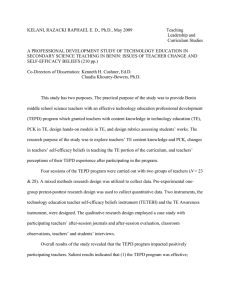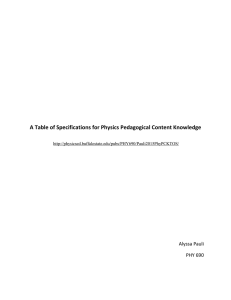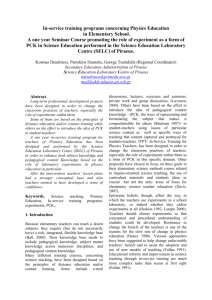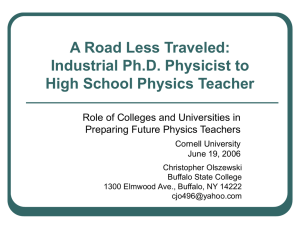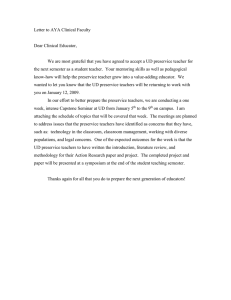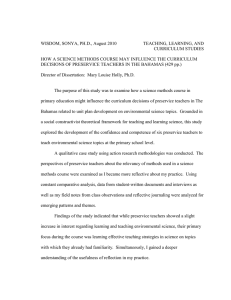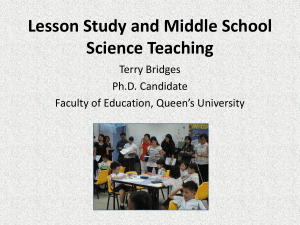Preservice Physics Teacher`s Pathway of
advertisement
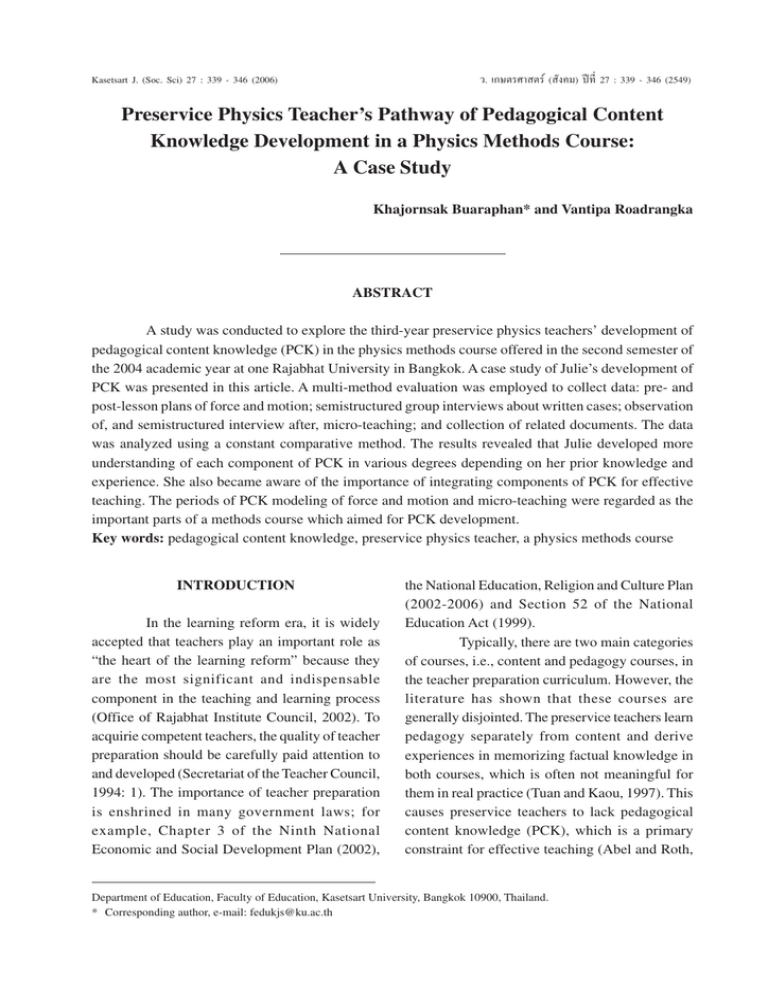
Kasetsart J. (Soc. Sci) 27 : 339 - 346 (2006) «. ‡°…µ√»“ µ√å ( —ߧ¡) ªï∑’Ë 27 : 339 - 346 (2549) Preservice Physics Teacher’s Pathway of Pedagogical Content Knowledge Development in a Physics Methods Course: A Case Study Khajornsak Buaraphan* and Vantipa Roadrangka ABSTRACT A study was conducted to explore the third-year preservice physics teachers’ development of pedagogical content knowledge (PCK) in the physics methods course offered in the second semester of the 2004 academic year at one Rajabhat University in Bangkok. A case study of Julie’s development of PCK was presented in this article. A multi-method evaluation was employed to collect data: pre- and post-lesson plans of force and motion; semistructured group interviews about written cases; observation of, and semistructured interview after, micro-teaching; and collection of related documents. The data was analyzed using a constant comparative method. The results revealed that Julie developed more understanding of each component of PCK in various degrees depending on her prior knowledge and experience. She also became aware of the importance of integrating components of PCK for effective teaching. The periods of PCK modeling of force and motion and micro-teaching were regarded as the important parts of a methods course which aimed for PCK development. Key words: pedagogical content knowledge, preservice physics teacher, a physics methods course INTRODUCTION In the learning reform era, it is widely accepted that teachers play an important role as “the heart of the learning reform” because they are the most significant and indispensable component in the teaching and learning process (Office of Rajabhat Institute Council, 2002). To acquirie competent teachers, the quality of teacher preparation should be carefully paid attention to and developed (Secretariat of the Teacher Council, 1994: 1). The importance of teacher preparation is enshrined in many government laws; for example, Chapter 3 of the Ninth National Economic and Social Development Plan (2002), the National Education, Religion and Culture Plan (2002-2006) and Section 52 of the National Education Act (1999). Typically, there are two main categories of courses, i.e., content and pedagogy courses, in the teacher preparation curriculum. However, the literature has shown that these courses are generally disjointed. The preservice teachers learn pedagogy separately from content and derive experiences in memorizing factual knowledge in both courses, which is often not meaningful for them in real practice (Tuan and Kaou, 1997). This causes preservice teachers to lack pedagogical content knowledge (PCK), which is a primary constraint for effective teaching (Abel and Roth, Department of Education, Faculty of Education, Kasetsart University, Bangkok 10900, Thailand. * Corresponding author, e-mail: fedukjs@ku.ac.th 340 «. ‡°…µ√»“ µ√å ( —ߧ¡) ªï∑’Ë 27 ©∫—∫∑’Ë 2 1992) and may be the weakest point of teacher preparation programs (Murray, 1998). Indeed, PCK should be developed in preservice teachers because it represents their ability to transform content knowledge they possesses into understandable forms for students with varied backgrounds (Shulman, 1987). The development of PCK in preservice teachers can affect the quality of their teaching and students’ achievement (GessNewsome, 1999). Among various courses in teacher preparation programs, a methods course is prominent because it extensively impacts upon preservice teachers’ quality of teaching (Haigh and Rehfeld, 1995). Importantly, during the process of learning to teach in this course, preservice teachers are inspired to integrate their content and pedagogy, and are provided with actual teaching practice and reflection (Veal et al., 2001). A methods course was therefore proposed as a potential place for preservice teachers’ development of PCK. To understand a methods course in the Thai context, the preliminary study was conducted in the science methods course at the university in Bangkok. There were two course instructors and 30 preservice science teachers (11 males, 19 females) participating in this study. The data collection methods included classroom observations, interviews with the course instructors, and questionnaires for the preservice teachers. The results indicated a lack of linkage between content and pedagogy used in the course – the course instructors seldom provided knowledge of teaching specific science topics to particular types of students. Accordingly, there was a need to revise methods courses to serve as potential sources of PCK development for preservice teachers. Although PCK appears to be an important attribute for preservice teachers, little is known about how preservice teachers develop their PCK and how various aspects of PCK are activated, integrated, and transformed into practice (van Driel et al., 1998). In Thailand particularly, there has been no research to study preservice physics teachers’ development of PCK in the physics methods course. Accordingly, this study was conducted in order to investigate the impacts of the PCK-based physics methods course upon the preservice physics teachers’ development of PCK. The research question was: “How, and to what extent, does the PCK-based physics methods course impact upon the preservice physics teacher’s development of PCK?” In this study, PCK is operationally defined as: “a preservice physics teacher’s ability to transform content knowledge that he/she possesses into understandable forms for students with variations in understanding, abilities, and characteristics by using appropriate instructional strategies and assessment.” PCK consisted of five major components: orientations toward teaching, knowledge of science curriculum, knowledge of students’ learning, knowledge of instructional strategies, and knowledge of assessment. METHODOLOGY Research design and setting This article presented a case study of PCK development in one third-year preservice physics teacher enrolled in the 16-week PCKbased Physics Methods Course conducted in the second semester of the 2004 academic year at a Rajabhat University in Bangkok. Her pseudonym was Julie. Research intervention: The PCK-based Physics Methods Course The constructivist theory is used as an epistemological basis in the course – preservice teachers construct PCK by linking their existing knowledge and experience with knowledge and experience derived from social interactions with the course instructor and their peers through «. ‡°…µ√»“ µ√å ( —ߧ¡) ªï∑’Ë 27 ©∫—∫∑’Ë 2 various learning activities in the course. In this case, PCK is both individually constructed and socially mediated (Borko and Putnam, 1996). During the first three weeks, various activities (e.g. reflection, discussion, group work, worksheets, etc.) were used for stimulating the preservice teachers to review, reflect upon, and develop their knowledge of curriculum, teaching strategies, and assessment, which are basic components of PCK. This aimed to prepare them to be ready to develop PCK. Additionally, in the first week, they were assigned to write the prelesson plans related to the topic of force and motion. Preparing lesson plans helped them to reflect upon and to develop their PCK by stimulating them to think critically about the physics content in the teaching perspective (de Jong et al., 1999). Experience in classrooms is one factor for PCK development (Veal et al., 1998: 33). Therefore, in the fourth week, the preservice teachers were required to observe a physics classroom and interview teachers, followed by discussion and reflection about the aspects learned. In the following two weeks, they were required to read and discuss two written cases, “force and inertia” and “reaction force”, which contain domain-specific dilemmas of teaching and learning these topics. These cases were used as an approach for capturing and developing their PCK (Daehler and Shinohara, 2001). To encourage the participants to create a desirable learning environment in their own classrooms, PCK modeling of force and motion was conducted during the seventh to eleventh week of the course. During this period, the participants were given the opportunities to derive direct experience as learners in the constructivist teaching and learning classroom, which would help them to create their own future classrooms (Borko and Putnam, 1996). In doing so, the course instructor took a role as a secondary physics teacher and the preservice teachers took roles as 341 secondary students. At the end of each week, the participants reflected upon and discussed aspects learned from PCK modeling activities. The contents included in this period were force and net force, Newton’s laws of motion, and change of momentum and force. Teaching experience is generally accepted as an important factor for PCK development (Veal, 1998; van Driel et al., 2002). Hence, during the twelfth to fifteenth week, each preservice teacher was required to perform microteaching of the topic of force and motion to their peers, who took roles as students. In the fifteenth week, they were also assigned to write the postlesson plan related to the topic of force and motion. The ability to reflect is also one factor which potentially influences teachers’ development of PCK (Tuan, 1996). Up to this point, at the end of each week, the preservice teachers were required to critically reflect upon the knowledge acquired and their learning experiences. In the final week particularly, they were required to reflect upon, discuss, and summarize what they had learned during the entire course. Throughout the course, formative and authentic assessment were used and integrated into the teaching and learning process through classroom observations, formal and informal interviews, students’ questions and answers, journals, portfolios, and related documents. Data collection and analysis A multi-method evaluation (Baxter and Lederman, 1999: 154) was used to capture Julie’s development of PCK including: pre- and postlesson plans of force and motion; semistructured group interview about written cases; observation of, and semistructured interview, after microteaching; and collection of related documents (e.g. worksheets, journals, portfolio). The data from various sources was analyzed by using a constant comparative method (Glaser and Strauss, 1967). Additionally, to enhance the trustworthiness of the 342 «. ‡°…µ√»“ µ√å ( —ߧ¡) ªï∑’Ë 27 ©∫—∫∑’Ë 2 study, these aspects were employed: prolonged engagement, persistent observation, methodological triangulation, rich description and audit trail. RESULTS AND DISCUSSION Background of Julie Julie came from the northeastern region of Thailand to study for a four-year B. Ed. degree in physics at Rajabhat University in Bangkok. She completed both primary and secondary education in her hometown and was regarded as a highachieving primary student. However, her secondary education went in the opposite direction because of a lack of attention to learning. This may be one factor which caused her to fail the university entrance exam. Fortunately, Julie qualified to study both Nursing Education and Physics Education. She decided to further her study of Physics Education because: “I like the ways my physics teacher taught at my secondary school. I love physics and expected to be a good and beloved physics teacher.” She is doing well in her chosen field. In her third year, she achieved a 3.48 GPA and took courses related to physics content, and education, and acquired some teaching experience. Julie’s starting point: expectations and perceptions about the physics methods course, the course instructor, and learning activities Julie started the physics methods course with the expectation of being a good and beloved physics teacher. She perceived all activities in the course as effective ways to accomplish her goals. The physics methods course instructor was perceived as a role model for teaching physics, and the teaching and learning process in the course was perceived to be the transmission mode of learning, i.e., students waited to receive knowledge which was transferred from a teacher. Interestingly, a survey of Julie’s prior knowledge revealed that, although Julie had already completed various courses related to curriculum, teaching and assessment, she knew little about them and had little teaching experience. Starting to transform Thai Science Curriculum into practice When Julie was required to analyze learning goals, teaching modes, learning materials, and assessment from the National Education Act (1999), the General Education Curriculum (2001), and the Thai Science Curriculum (2002) and their relationships, she started to think about, and to identify commonalties across, those documents. This task not only enhanced her knowledge of curriculum, but also stimulated her to think about how to transform curriculum into practice. I plan to apply key ideas mentioned in those documents as the guidelines to: (a) write lesson plans; (b) set learning activities suitable to students’ interests and skills; and (c) help students to learn by direct-experience, thinking and practice; and (d) emphasize students as being most important. (First week worksheet) Feeling uncomfortable with constructivist activities At the end of the first week, Julie reflected that she felt uncomfortable with constructivist learning activities employed in the course because they differed from the transmission mode of learning (i.e., lecture) with which she was familiar. Constructivist learning activities demanded more thinking skills and many tasks to accomplish the learning goals. Gradually adapting to constructivist activities In the second week, when Julie was required to analyze key ideas, teaching and learning, and strengths and weaknesses of transmission and constructivist modes of learning, she demonstrated a greater understanding of these modes of learning, especially the constructivist mode of learning. She mentioned that this mode «. ‡°…µ√»“ µ√å ( —ߧ¡) ªï∑’Ë 27 ©∫—∫∑’Ë 2 of learning corresponded with the National Education Act (1999), the General Education Curriculum (2001) and the Thai Science Curriculum (2002) because: It emphasized each individual student to construct knowledge by him/herself. The teacher’s role was to encourage, support, and guide students to construct knowledge. Students need to be active learners who take part in discussing, criticizing, acquiring and developing their ideas, not just waiting to receive knowledge from the teacher. (second week worksheet) As Julie increased her understanding of the constructivist mode of learning and gained direct experiences from attending constructivist learning activities, she gradually developed more positive attitudes toward constructivist learning activities and adapted to them. Julie’s perceptions about assessment and evaluation Julie perceived assessment and evaluation to be: “A tool to test students’ knowledge before, during, and after teaching. What is derived from a test is a number. Evaluation is the interpretation of that number into a score or grade.” After she finished reading and discussing formative, summative, and authentic assessment, she showed a further understanding of assessment, especially formative assessment. She informed us that she used classroom observation, students’ questions and answers, journals, worksheets, tasks, experiments, pre and post-tests, and portfolios to assess students’ learning. Julie’s pre-lesson plan of Newton’s third law of motion There were four weak points in Julie’s pre-lesson plan of Newton’s third law of motion. First, the affective domain (e.g., attitudes) were not explicitly mentioned in the teaching objectives. Second, there were no details concerning probing questions, expected answers, and the activities 343 used. Third, the tug-of-war activity used could not lead students to understand that action equals reaction and action-reaction force can act at a distance. Finally, there was no activity in the conclusion stage to encourage students to apply learned knowledge to their daily-lives as mentioned in teaching objectives. Observing physics class and interviewing the physics teacher: valuable experience Julie reflected that observing physics classes and interviewing the physics teacher gave her valuable experience. She learned many techniques from the weak and strong points of the teacher’s teaching; for example, having a good understanding of the topic taught, using good probing questions, using interesting teaching materials, paying attention to all students, emphasizing students as most important, and encouraging students’ self-construction of knowledge. Experience from this task incorporated with prior knowledge and experience of constructivist activities enhanced Julie’s intention to use constructivist teaching strategies: “I will not stick to a traditional lecture strategy. On the contrary, I will apply constructivist activities to my future teaching to encourage students to construct knowledge by themselves.” Importantly, Julie started to be aware of the importance of representing content suitable to students’ backgrounds, i.e. the key idea of PCK. Written cases discussion: Stimulating Julie’s thinking about PCK In written case discussions, Julie could identify the teacher ’s and students’ misunderstanding of Newton’s first law of motion and reaction force. She learned that questions used should be arranged from simple to complex and linked with students’ lives, and various teaching materials should be used to stimulate student interest. Julie also expressed understanding of the constructivist theory relating to the student’s role: 344 «. ‡°…µ√»“ µ√å ( —ߧ¡) ªï∑’Ë 27 ©∫—∫∑’Ë 2 “Students must change their learning style from ‘the receiver’ to ‘the thinker’.” Importantly, Julie combined many components of PCK. PCK modeling of force and motion: Crucial period for developing PCK Direct experience as a learner in wellprepared constructivist activities during the period of PCK modeling strongly influenced Julie’s thinking about teaching and learning physics and also about PCK. Her thinking about teaching and learning (e.g., setting teaching objectives, introducing the lesson, teaching, concluding the lesson, and assessing students’ learning) was more complex. In addition, she increased the complexity of relationships among the components of PCK. Micro-teaching: Integrating various components of PCK into real practice From her and her peers’ micro-teaching, Julie raised various important issues: the effects of lacking content and materials preparation, and wait-time; using a series of probing questions, constructivist strategies, teaching materials and post-test; altering students’ misunderstandings; and time constraints. These issues stimulated Julie’s to think in a more complex way about teaching, learning, and PCK – integrating various components of PCK into practice. Julie’s postlesson plan of Newton’s third law of motion improved remarkably. There were many strong points: the coverage of teaching objectives, teaching by emphasizing students’ hands-on experience, knowledge application and cooperative learning; providing good probing questions; and using activities (e.g. the tug-of-war activity) to make students understand actionreaction force. However, preservice teachers should have the opportunity to practice microteaching with real students instead of peers because authentic experience with real students and real lessons in a classroom context can strongly enhance their knowledge of students’ learning (Tuan, 1996). Summary Although this study revealed that Julie developed incomplete PCK, she tended to progressively develop more complete PCK by increasing the complexity of relationships among various components of PCK. The finding supports the literature which states that novice or preservice teachers normally have no or little PCK and that developing PCK is a time-consuming task. However, PCK can be developed by giving preservice teachers adequate teaching experience over time with multiple opportunities to teach, observe, and reflect upon their own teaching of a particular topic as well as the teaching of the topic by others (Halim and Meerah, 2002; van Driel et al., 2002). Similar to Tuan and Kaou (1997), this study also revealed that Julie’s perceptions of curriculum, teaching, learning, assessment, and content influenced her development of PCK, influenced her inclination to use constructivist strategies and formative assessment, and increased her awareness of the importance of teachers’ content knowledge and knowledge of students’ learning (e.g. students’ alternative conceptions). IMPLICATIONS The limitation of a case study like Julie’s development of PCK presented in this article was its generalization. However, various implications may arise from this study. First, a methods course should be considered by all concerned as an important opportunity and a potential source for development of preservice teachers’ PCK. Second, activities included in such a course should be carefully and systematically planned by using the constructivist theory as an epistemological base. That is, preservice teachers’ existing knowledge and experience related to components of PCK must be taken into account as guidelines for designing activities to enhance their understanding of each component of PCK and their integration of all components into PCK. Third, teaching experience «. ‡°…µ√»“ µ√å ( —ߧ¡) ªï∑’Ë 27 ©∫—∫∑’Ë 2 should be considered to be a major factor affecting PCK development. Therefore, preservice teachers should have multiple opportunities to teach, observe, and reflect upon their own teaching and the teaching of others. Classroom observation, written case discussions, PCK modeling, and micro-teaching are important components that should be included in a methods course. Finally, the course should deepen preservice teachers’ content knowledge, further their understanding of the concepts found to be difficult for students, and increase their understanding of students’ alternative concepts. ACKNOWLEDGEMENTS This study was granted by the Institute for the Promotion of Teaching Science and Technology (IPST) and the Graduate School, Kasetsart University, Bangkok, Thailand. LITERATURE CITED Abel, K. S. and M. Roth. 1992. “Constraints to Teaching Elementary Science: A Case Study of a Science Enthusiast Student Teacher”. Science Education 76(6): 581-595. Barnett, C. 1992. “Building a Case-based curriculum to enhance the pedagogical content knowledge of mathematics teachers”. Journal of Teacher Education 42(4): 263-272. Baxter, J. A. and N. G. Lederman. 1999. “Assessment and measurement of pedagogical content knowledge”, pp.147-161. In J. GessNewsome and N. G. Lederman (eds.). Examining pedagogical content knowledge. Dordrecht, The Netherlands: Kluwer Academic Publisher. Borko, H. and R. T. Putnam. 1996. “Learning to Teach”. pp. 673-708. In D. C. Berliner and R. C. Calfee (eds.). Handbook of educational psychology New York: Macmillan. Daehler, K. R. and M. Shinohara. 2001. “A 345 complete circuit is a complete circle: Exploring the potential of case materials and methods to develop teachers’ content knowledge and pedagogical content knowledge of science”. Research in Science Education 31: 267-288. de Jong, O., M. Ahtee., A. Godwin., V. Hatzinikita. and V. Koulaidis. 1999. “An international study of prospective teachers’ initial teaching conceptions and concerns: The case of teaching ‘combustion’”. European Journal of Teacher Education 22(1): 45-59. Gess-Newsome, J. 1999. “Pedagogical content knowledge: An introduction and orientation”. pp.3-17. In J. Gess-Newsome and N. G. Lederman (eds.). Examining pedagogical content knowledge Dordrecht, The Netherlands: Kluwer Academic Publisher. Glaser, B. G. and A. L. Strauss. 1967. The discovery of grounded theory: Strategies for qualitative research. Chicago, Illinois: Aldine Publishing Company. Haigh, W. and D. Rehfeld. 1995. “Integration of secondary mathematics and science methods courses: A model”. School Science and Mathematics 95(5). Available: http://80-web14.epnet.com.ezproxy.waikato.ac.nz: 2048/citation.asp?tb=1 Halim, L. and S. M. Meerah. 2002. “Science trainee teachers’ pedagogical content knowledge and its influence on physics teaching”. Research in Science and Technological Education 20(2): 215-225. Murray, F. B. 1998. “Reforming teacher education: Issues and the join effort of education and liberal arts faculty”. The History Teacher 31(4): 503-519. Office of Rajabhat Institute Council. 2002. Conceptual framework to reform the teacher and educational personnel preparation and development. Available: http://www.rajabhat. ac.th/edu/develop.htm. Secretariat of the Teacher Council. 1994. The 346 «. ‡°…µ√»“ µ√å ( —ߧ¡) ªï∑’Ë 27 ©∫—∫∑’Ë 2 seminar on guidelines for shifting teaching profession standards. Bangkok: Secretariat of the Teacher Council. Shulman, L. S. 1987. “Knowledge and teaching: Foundations of the new reform”. Harvard Educational Review 57(1): 1-22. Tuan, H. 1996. “Investigating the nature and development of pre-service chemistry teachers’ content knowledge, pedagogical knowledge and pedagogical content knowledge”. pp. 101-112. In Proceeding of National Science Council, Part D: Mathematics, Science & Technology Education. Tuan, H. L. and R. C. Kaou. 1997. “Development of a grade eight Taiwanese physical science teachers’ pedagogical content knowledge development”. pp. 135-154. In Proceeding of the National Science Council Part D: Mathematics, Science and Technology Education. van Driel, J. H., O. de Jong and N. Verloop. 2002. “The development of preservice chemistry teachers’ pedagogical content knowledge”. Science Education 86: 572-590. van Driel, J. H., N. Verloop. and W. de Vos. 1998. “Developing science teachers’ pedagogical content knowledge”. Journal of Research in Science Teaching 35(6): 673-695. Veal, W. R. 1998. The evolution of pedagogical content knowledge in prospective secondary chemistry teachers. Paper presented at the annual meeting of the National Association for Research in Science Teaching, San Diego, CA. Veal, W. R., J. van Driel and H. Hulshof. 2001. “Review of pedagogical content knowledge: How teachers transform subject matter knowledge”. International Journal of Leadership in Education 4(3): 285-291.

